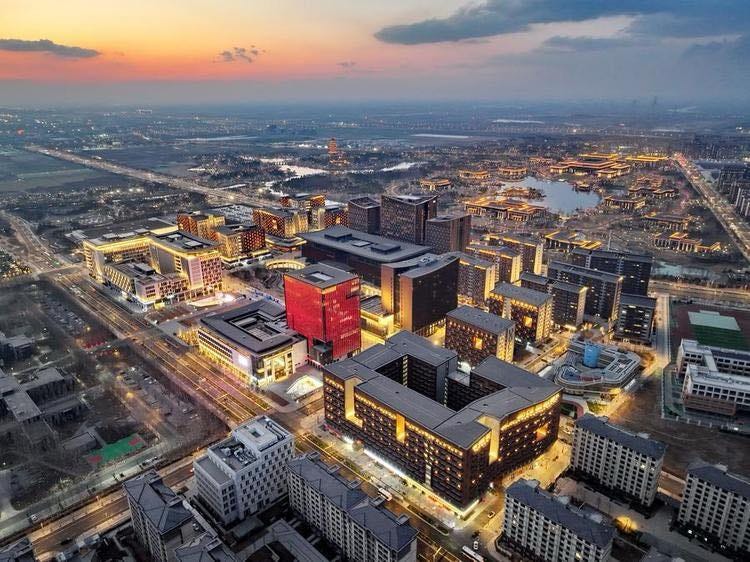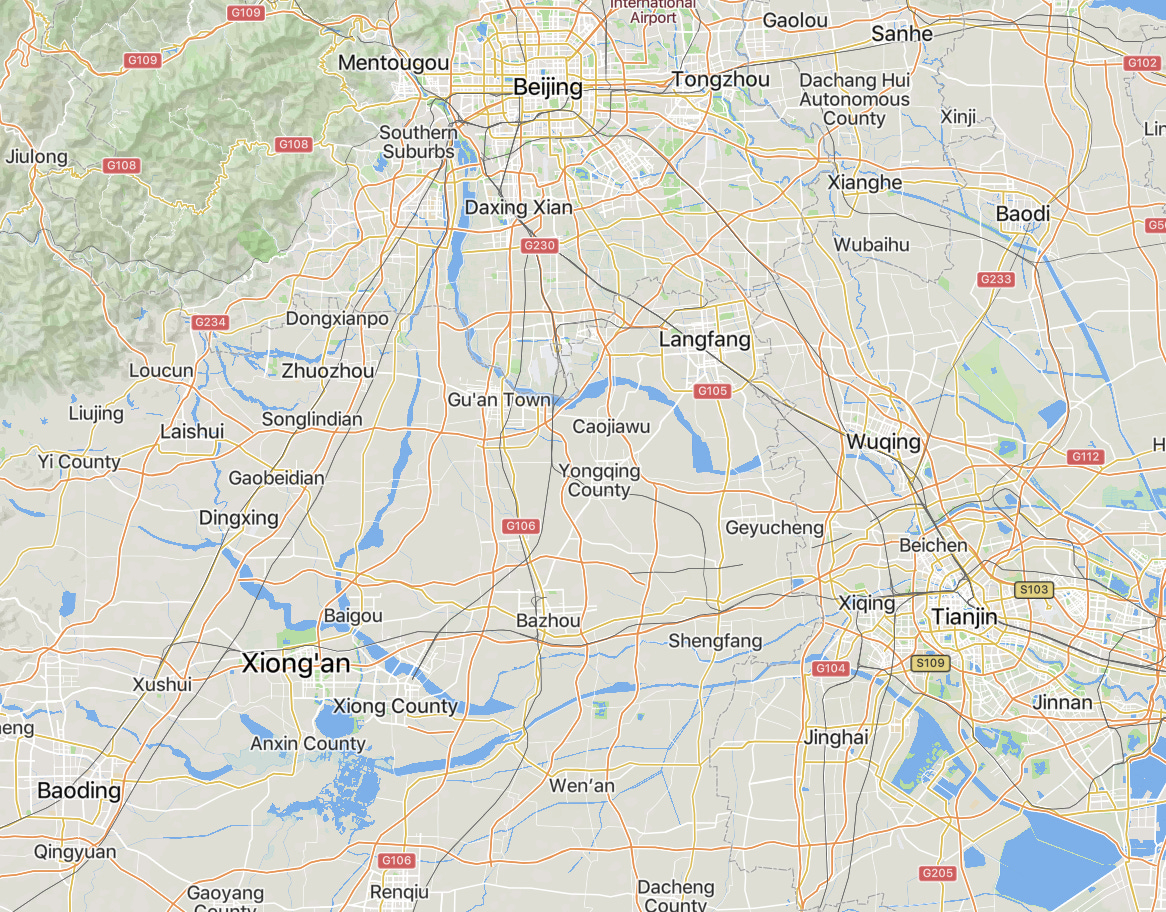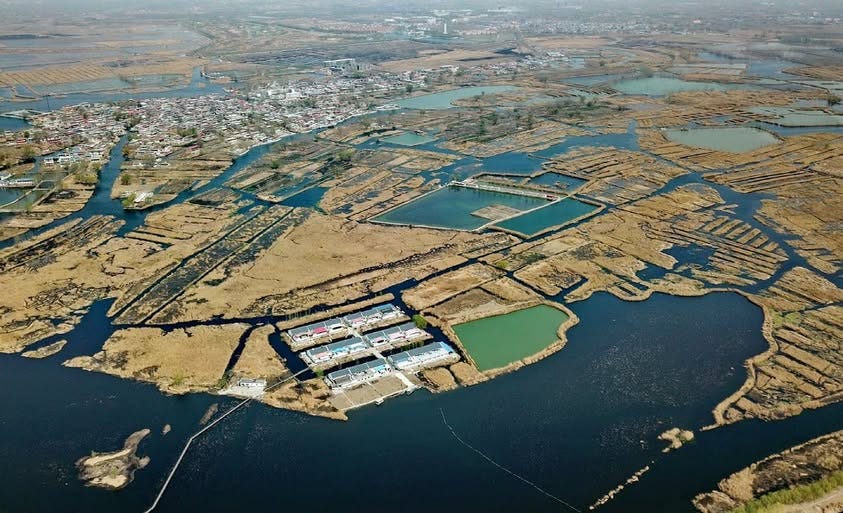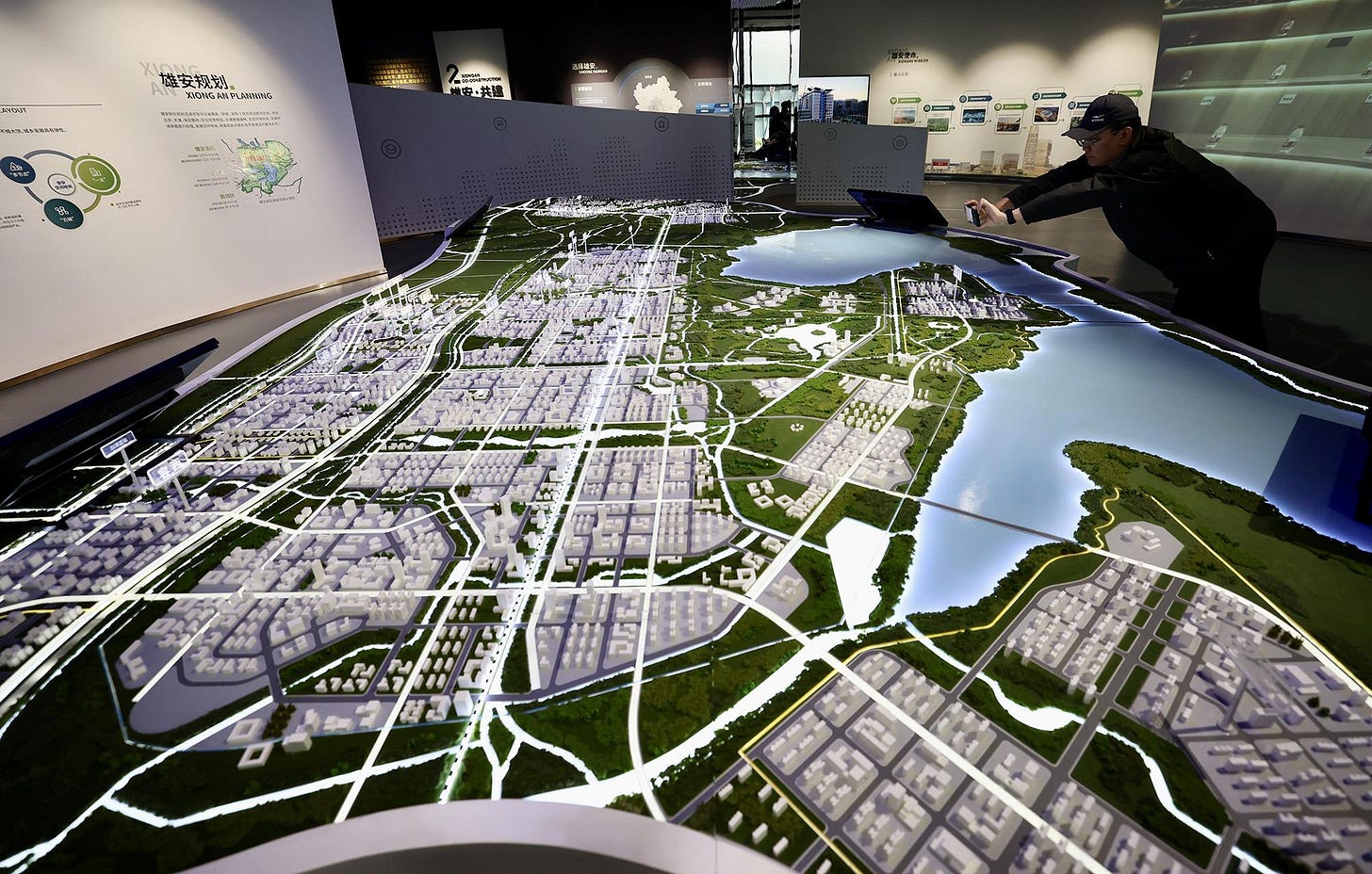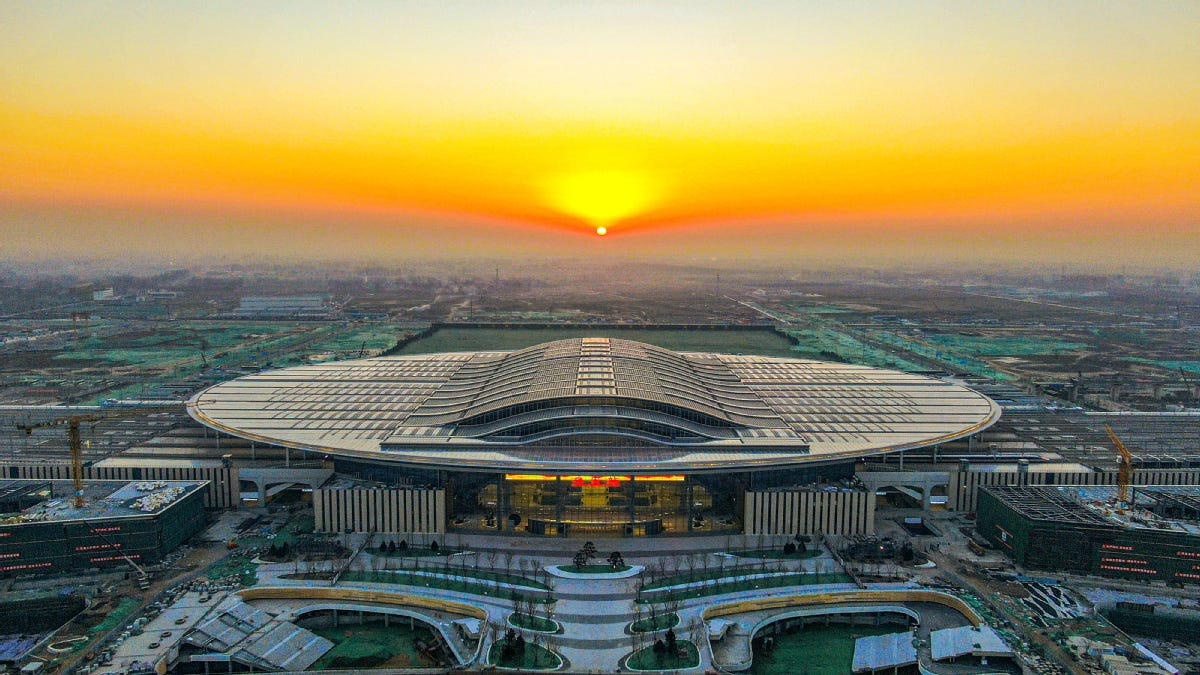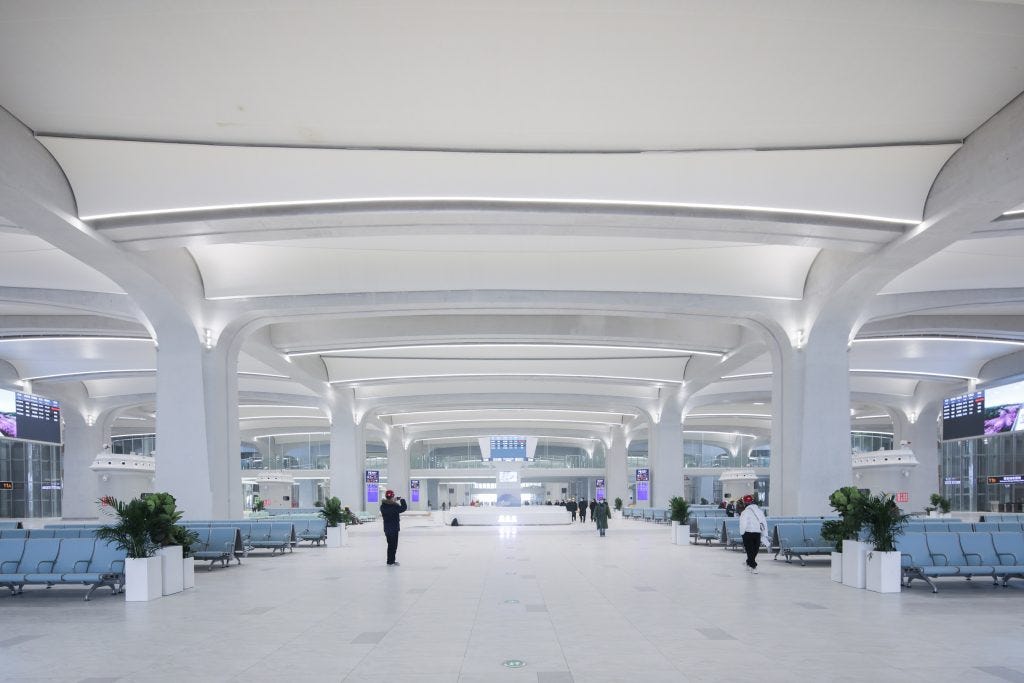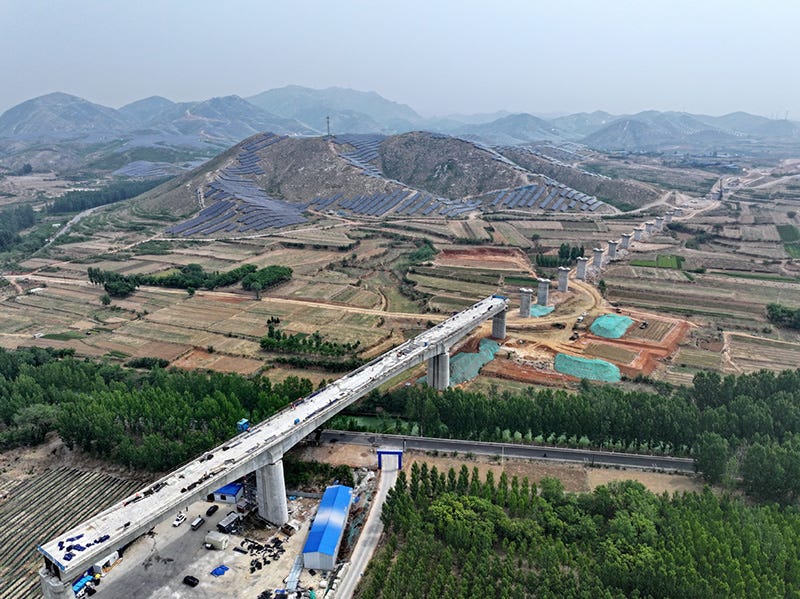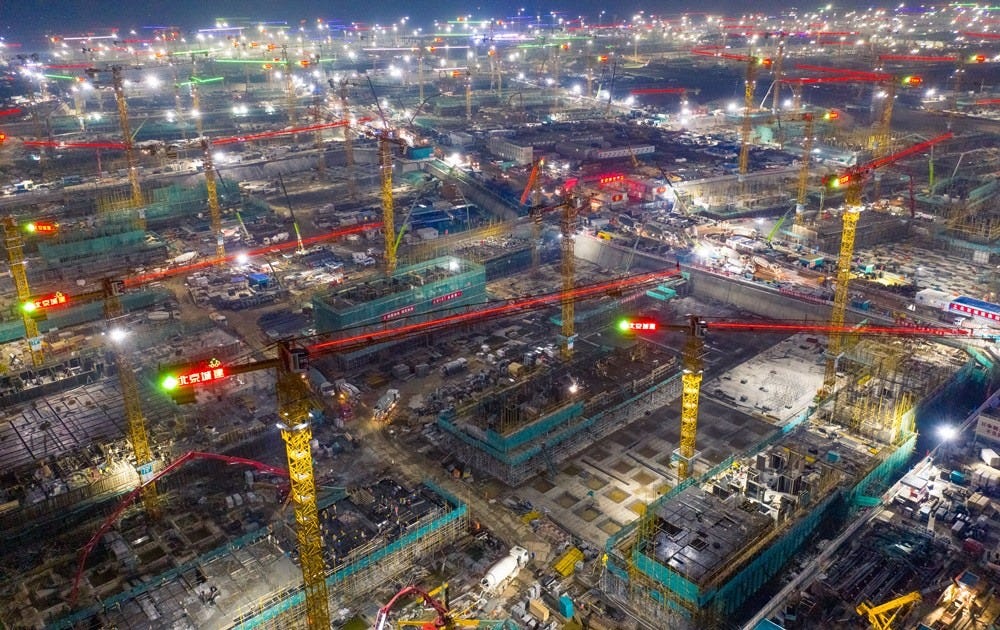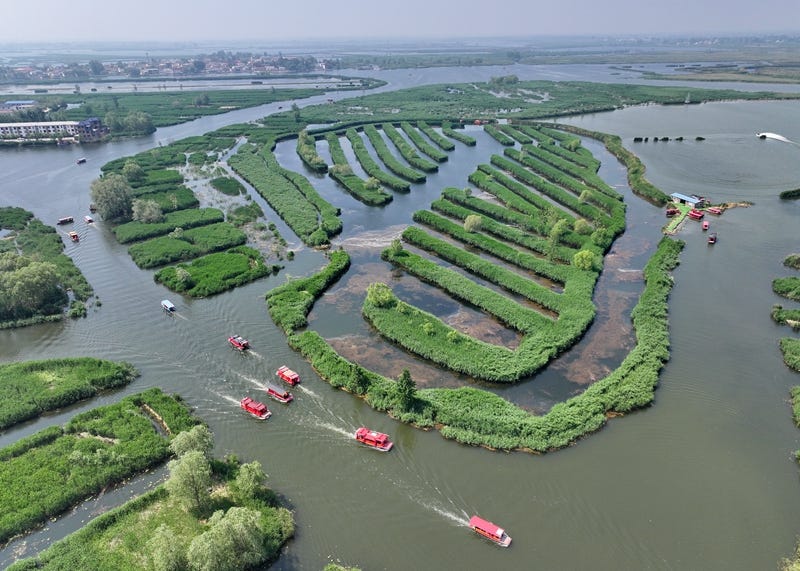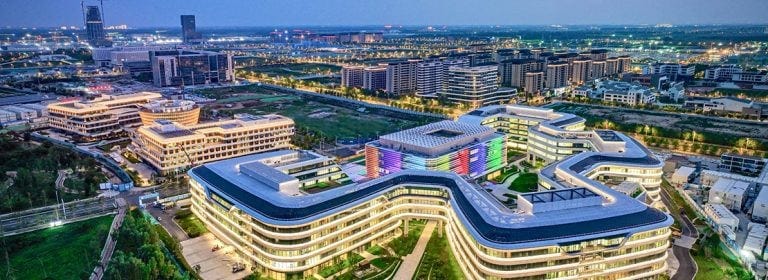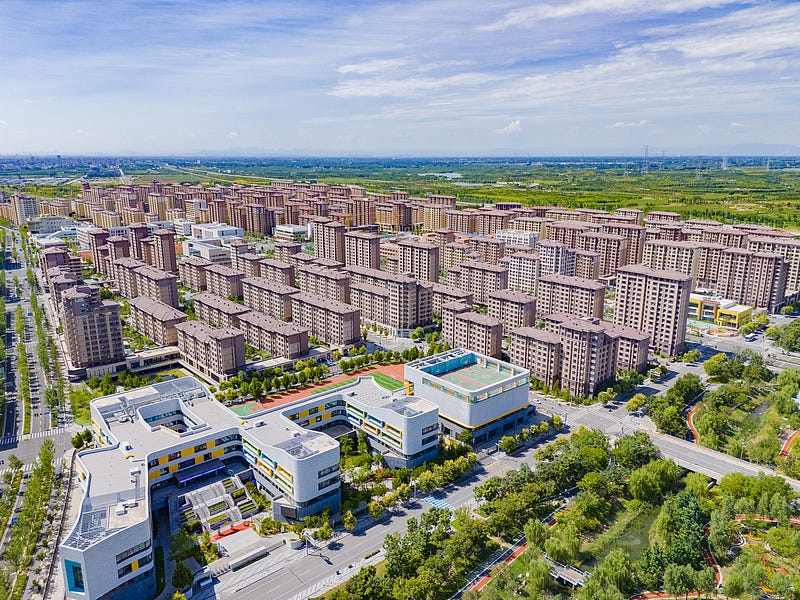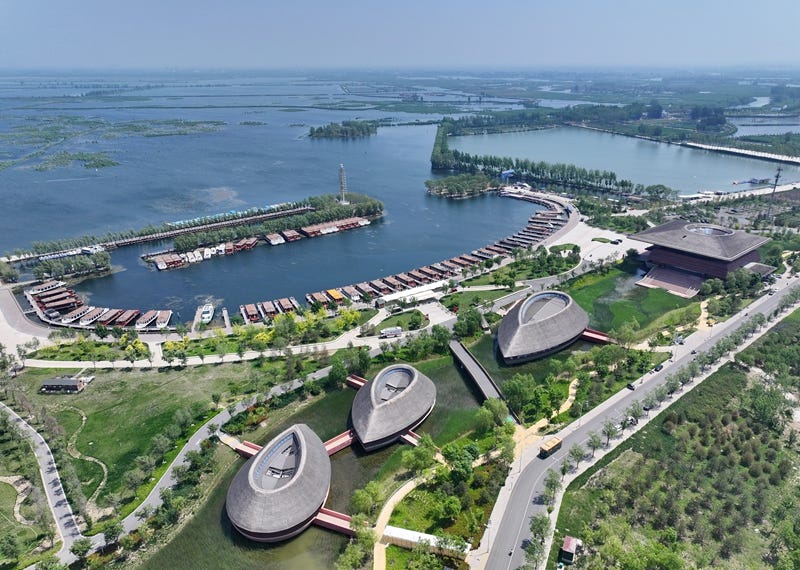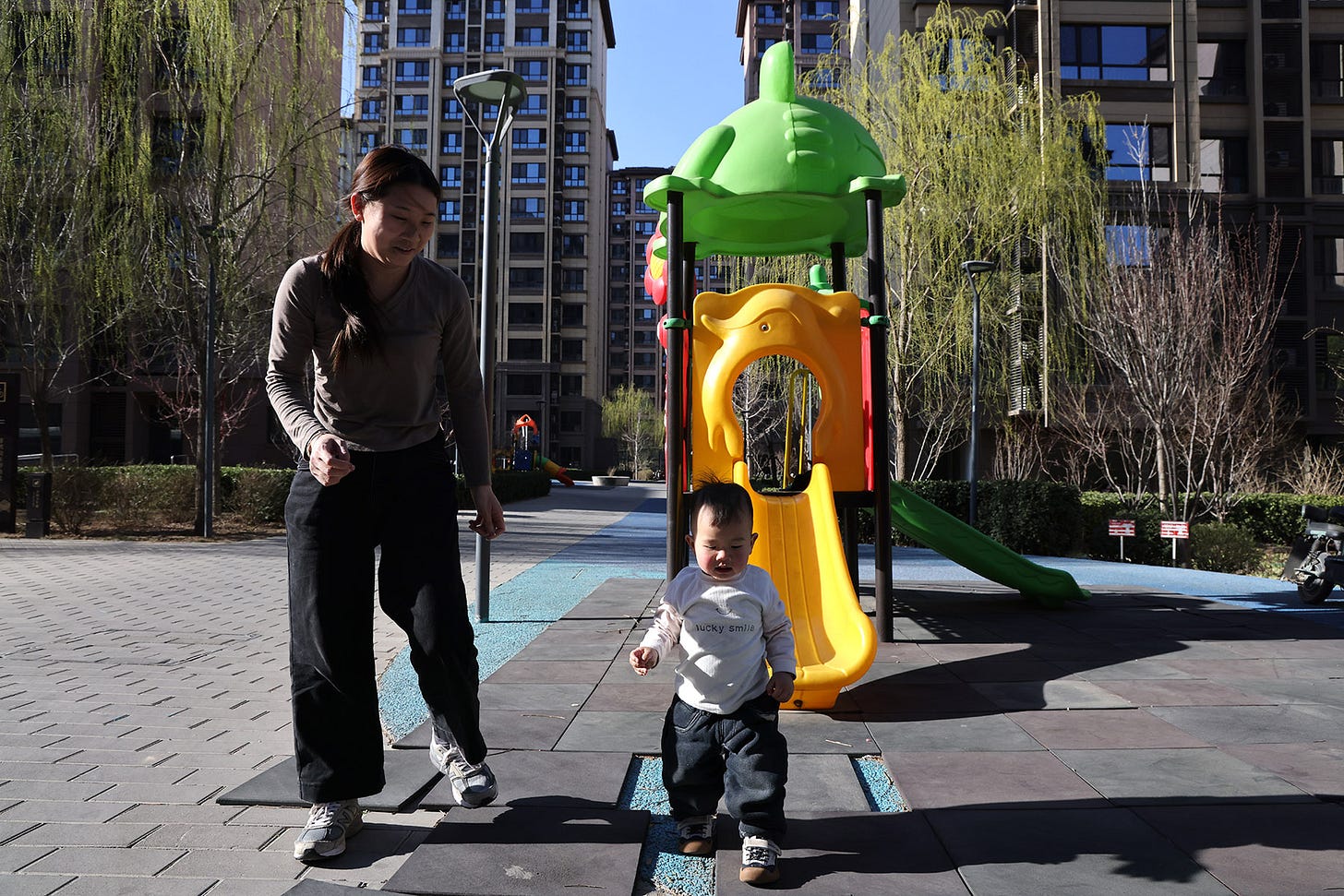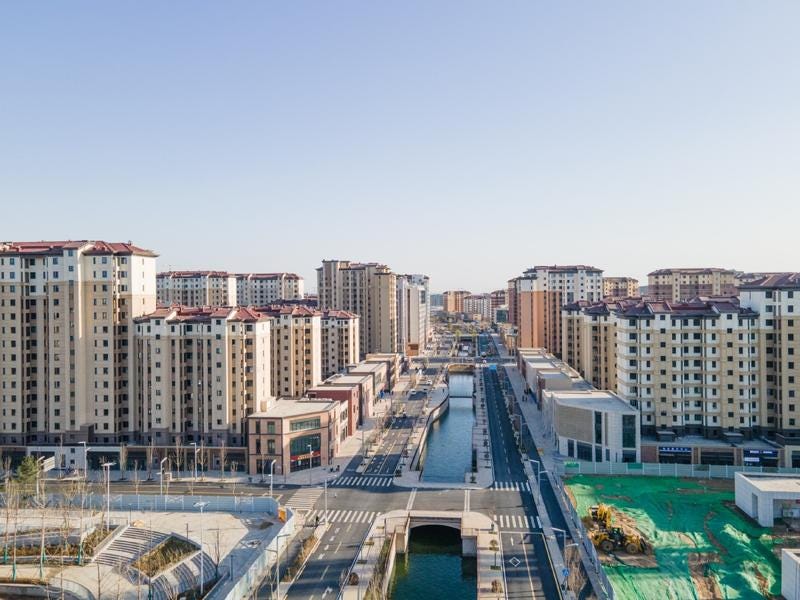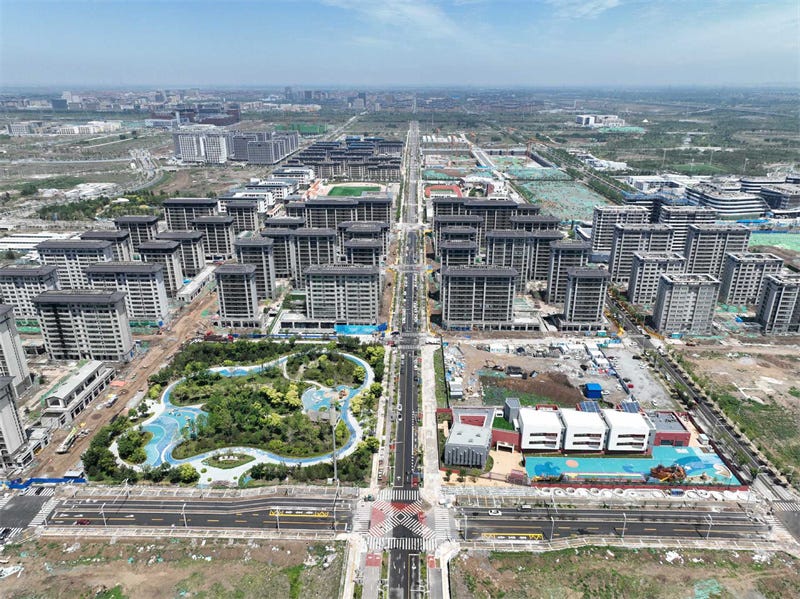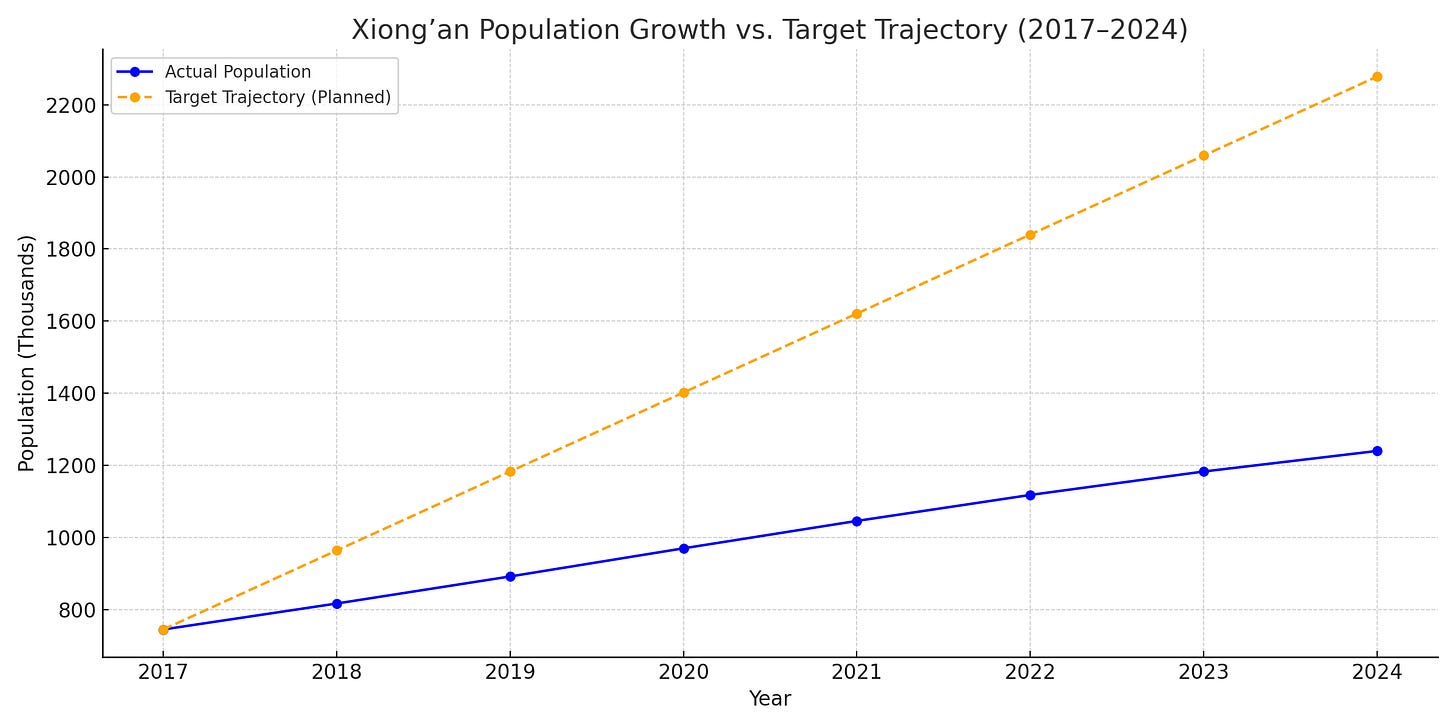Can China Force a City to Life? The Xiong'an Experiment
How Beijing’s $580 Billion Floodplain Gamble Could Redefine Urbanization
Xiong’an City Centre | Amazing Hebei
Rising from the floodwaters of Baiyangdian Lake, Xiong’an represents China’s most audacious urban experiment: a metropolis built not by organic growth, but by fiat. Its success or failure may redefine whether cities can truly be engineered into existence.
1. Introduction: The Xiong’an Paradox
Week 2 of China in 5's 707 City Journey
Last week we decoded Hefei’s quantum gamble, how a second tier city turned science into an economic engine becoming China’s Silicon Valley (Read Hefei’s Story). Today, we pivot to China’s most audacious urban experiment: building the future on a floodplain.
Announced in 2017, Xiong’an New Area represents Beijing’s ultimate weapon against capital congestion; a meticulously planned metropolis for 5 million, where AI governs traffic and carbon neutral towers rise from wetlands. But this vision faces a hydrological reality: engineers first had to spend $15 billion taming the Baiyangdian Lake floods just to break ground.
The Paradox
Political Dream: A decentralized, innovation driven alternative to Beijing’s sprawl
Geographic Truth: A site where water tables rise faster than buildings
Every July 9th for the next 13.6 years, China in 5 will deliver annual updates tracking Xiong’an’s metamorphosis. Will it become a sustainable urban template? Or prove that even China’s top-down mastery has limits?
This is Week 2 of China in 5’s Season 1: 34 Cities, 34 Provinces, an 8 month long journey to decode China’s urban future. Explore the full Season 1 roadmap.
2. The Decision: Why Xiong’an and Not Elsewhere?
When Beijing unveiled plans for the Xiong’an New Area in 2017, one question loomed large: Why build a flagship city of the future on a flood prone site 100 kilometers southwest of the capital? The location was neither arbitrary nor accidental, it reflected a calculated balance of control, symbolism, and strategic experimentation.
i. Proximity vs. Control
Location of Xiong’an | Map Carta
Geographically, Xiong’an’s 100 kilometer distance from Beijing served dual purposes. It was close enough to ensure tight oversight from central authorities, avoiding the autonomy that characterized early special economic zones like Shenzhen. Yet it was far enough to prevent the unchecked urban sprawl that had absorbed nearby cities like Baoding and Langfang into Beijing’s orbit. Unlike these alternatives, Xiong’an offered a true tabula rasa, a space unburdened by legacy industries or competing local interests, where the state could implement its vision without negotiation.
Other candidate zones, such as Tianjin’s Binhai New Area or Zhuozhou, had obvious advantages: Tianjin boasted port access and established infrastructure, while Zhuozhou already had rail links to Beijing. But these sites were rejected for reasons that reveal Beijing’s priorities. Tianjin’s strong local government resisted becoming a mere "relief valve" for the capital, while Zhuozhou’s proximity risked blending into Beijing’s uncontrolled expansion, the very problem Xiong’an aimed to solve.
Critically, Xiong’an’s challenges, particularly its flood prone terrain around Baiyangdian Lake were not ignored but reframed as an opportunity.
Xiong’an Floodplain 2019 | China SCIO
By transforming a hydrological liability into a showcase for China’s engineering prowess, the project could signal the Party’s ability to conquer even the most unforgiving landscapes. As Rogers (2021) observes in China’s Urban Revolution, Xiong’an exemplifies the Party’s ‘engineering fetishism’; the deliberate selection of technically daunting sites to demonstrate state capacity1.
This aligns with what one urban planner involved in early discussions privately noted: ‘Xiong’an wasn’t chosen despite its challenges; it was chosen because of them. The floodplain was a blank canvas for Beijing to prove its mastery over geography and governance’2.
The decision ultimately underscored a broader truth: Xiong’an was never just about relieving Beijing’s congestion. It was a hierarchical experiment, a test of whether China’s top down model could conjure a modern metropolis from scratch, on terms set entirely by the state.
ii. Symbolic Tabula Rasa: Engineering a Model City from Scratch
Unlike older industrial hubs like Tianjin or Baoding, burdened with legacy factories and entrenched local interests, Xiong'an offered planners a rare opportunity: a true blank slate. With minimal existing development, the site allowed authorities to avoid politically fraught restructuring of outdated industries or compensation battles with displaced residents3.
Xiong’an Master Plan | Chapman Taylor
This absence of historical baggage was deliberate; as noted in the NDRC's 2018 Master Plan4, the location enabled "unconstrained implementation of innovative urban paradigms" free from "path dependencies of traditional industrial cities"5. The symbolism was potent, a 21st century Shenzhen, but one where the state maintained total control from inception without negotiating with existing power structures.
iii. Floodplain as a Feature: Hydro-Engineering as Political Theater
The Baiyangdian Lake floodplain’s hydrological challenges were strategically reframed from liability to showcase. Where conventional urban planning might avoid such terrain, Xiong’an’s designers deliberately weaponized the site’s difficulties to demonstrate China’s technical mastery6.
Baiyangdian Floodplain 2022 | SCIO
The $15 billion Baiyangdian Ecological Restoration Project, with its 200km of reinforced embankments and AI controlled floodgates became what engineering scholars term a techno-political spectacle7, transforming water management infrastructure into visible proof of national capability. This aligns with what political ecologists identify as China’s "triumphalist environmental governance" model8, where nature’s conquest serves state legitimacy. As then-Mayor Chen Gang proclaimed in 2019: We’re not just building a city, we’re writing China’s new hydrological civilizational code.9
iv. Institutional Considerations in Site Selection
While official documents emphasize Xiong’an’s technical merits, some policy analysts note that the decision making process reflected broader institutional priorities. As Tsinghua University urban scholar Xun observed, The choice of a greenfield site in Hebei—rather than expanding existing Tianjin or Baoding projects, allowed for unfettered central oversight, minimizing coordination with local governments.10
This aligns with the State Council’s 2017 directive emphasizing unified central leadership11 in Xiong’an’s development. The NDRC’s avoidance of existing urban centers may reflect practical governance considerations as much as hydrological or geographic factors.
3. Planning: The Brains Behind the Blueprint
Xiong’an New Area Urban Masterplan | Chapman Taylor
i. Strategic Direction
The development of Xiong'an New Area followed China's hallmark top-down planning approach, initiated when the State Council issued its April 2017 notice establishing the special economic zone12. The full planning framework was formalized in the Hebei Xiong'an New Area Planning Outline approved by the Central Committee and State Council in April 2018, which mandated ecological priority, innovation driven development, and population controls as core principles13.
Xiong’an Plan Model | China Daily
ii. Technical Implementation
a. Lead Actors
Operational responsibility fell to the National Development and Reform Commission (NDRC), which coordinated 58 state owned design institutes under its Xiong'an Planning Leadership Group14. The China Academy of Urban Planning & Design15 took lead responsibility for spatial planning, as evidenced by its 12 core area projects (CAUPD, 2017-2020), while Tsinghua University's School of Architecture developed Baiyangdian's ecological security patterns using advanced hydrological modeling16. This division of labor was formally institutionalized in Hebei Province's 2019 regulatory plans.
Construction in Motion, Rongxi July 2021 to March 2023 | SCIO
b. Key Institutions
At the local level, Hebei Province's role was deliberately circumscribed to implementation rather than planning. The Beijing-Hebei Xiong'an Coordination Mechanism17 established clear parameters for provincial involvement, including prohibitions on land sales without central approval and requirements for direct reporting lines to Beijing. This structure ensured that while local knowledge and resources could be utilized, ultimate decision making authority remained firmly with central authorities. The resulting planning process exemplified China's centralized approach to major development projects, combining high level strategic direction with technical expertise and localized implementation.
c. Private Sector
While Xiong’an is primarily a state-driven project, private tech giants have played a key role in developing its smart city infrastructure. Firms like Baidu, Alibaba, and Tencent (BAT) were brought in as technical consultants to design the digital backbone of the new city.
Xiong’an Start Up Centre Under Construction April 2025 | Xiong’an City
Baidu’s AI & Autonomous Driving. Following high-profile agreements18 signed in 2018-2019, Baidu deployed its Apollo autonomous driving platform for Xiong'an's intelligent transportation network.
Alibaba’s Cloud & City Brain. Alibaba signed a strategic cooperation agreement19 in 2018 to Implement AI powered urban management similar to Hangzhou’s City Brain.
Tencent’s Digital Services. Tencent contributed digital governance solutions through its WeChat ecosystem and cloud infrastructure, as documented in its corporate reports20
These partnerships exemplify China's hybrid development model, where private tech giants provide cutting edge solutions while operating within strict government parameters. However, scholars note this arrangement differs fundamentally from market driven urban tech projects in the West, as Chinese firms function more as state sanctioned contractors than independent innovators.21 The collaboration has yielded measurable outcomes, including the world's largest urban scale IoT network by 202222, though questions persist about data governance and the private sector's actual decision-making authority in the project.
iii. Balancing Ideology and Pragmatism
The development of Xiong’an reflects a deliberate negotiation between ideological vision and technical pragmatism, achieved through a structured, multi layered planning process. At the strategic level, the State Council’s 2017 master plan established non negotiable political principles, ecological civilization, innovation driven development, and socialist urban ideals that served as the project’s ideological foundation. These directives were then operationalized through technical frameworks developed by the NDRC and its consortium of 58 state-affiliated design institutes, which translated broad political objectives into implementable plans.
The planning process exhibited three key adaptive mechanisms that reconciled ideological and practical demands:
Technical Mediation of Political Goals
The Baiyangdian Lake ecological restoration project exemplifies this balance. While the political mandate required demonstrating "harmony between man and nature," engineers from Tsinghua University developed pragmatic solutions, including AI regulated floodgates and sponge city technologies to address the site’s hydrological challenges without compromising development timelines.
Phased Implementation as Risk Mitigation
The division into distinct phases23 allowed planners to test ideological concepts like green urbanism in controlled pilot zones before scaling, reducing implementation risks.
Nested Decision Making Authority
The Beijing Hebei Coordination Mechanism created separate channels for ideological compliance and technical execution (delegated to provincial level specialists), preventing bureaucratic gridlock.
This process produced measurable outcomes: over 75% of Phase 1 infrastructure met both political sustainability targets and international engineering standards24 . However, tensions persist in areas like population growth, where ideological caps conflict with economic pragmatism a challenge acknowledged in internal NDRC assessments but resolved through adaptive policies like talent quotas for high tech workers.
4. Deployment: How the Plan Became Reality
Phase 1 (2017–2022): Laying the Foundations
The initial five-year phase focused on transforming Xiong’an from a rural floodplain into a functional urban area capable of supporting Beijing’s decentralized functions. This required overcoming significant geographical constraints while adhering to strict political and ecological mandates.
The one that Remained, Yuerong Park; Xiongan | Xinhua
4.1 Infrastructure Construction
State owned enterprises (SOEs) spearheaded the physical transformation:
i. Flood Adaptive Transport Infrastructure: Engineering Synergy Between Mobility and Hydrology
Xiong'an Railway Station (2023) | China Daily
China Railway Group and China State Construction Engineering Corporation (CSCEC) approached Xiong'an's transport network as an integrated water management system, not merely a circulation grid. Their designs for expressways, the Beijing-Xiong'an Intercity Railway (R1 Line), and underground utility tunnels incorporated three millennia of flood control wisdom with quantum era engineering:
Inside the Xiong’an Railway Station | Infra Global
a. Elevated Rail as Flood Buffer
The 92km Beijing Xiong'an railway embankment was constructed using compacted loess layers alternating with geosynthetic clay, a technique adapted from 11th century Yellow River dikes. This elevated corridor simultaneously serves as a flood diversion barrier, redirecting overflow into designated wetland recharge zones during extreme weather events25.
Xiong’an - Xinzhou High Speed Rail March 2025 | Xinhua
b. Self-Draining Smart Pavements
Expressways feature permeable nano ceramic asphalt26 with embedded fiber optic sensors that monitor saturation levels. When flood risk exceeds threshold, the system automatically activates subterranean drainage gates patterned after Ming Dynasty qanats, achieving 800% faster water dispersion than conventional systems27 .
Xiong’an Construction (2020) | People’s Daily
c. Amphibious Utility Tunnels
The 48km underground utility network combines:
Self-sealing joints using Warring States era lacquer tree resin formulations
AI controlled buoyancy chambers based on Yuan Dynasty shipbuilding techniques. Allowing entire tunnel segments to safely float during floods while maintaining power/water flows (Xiong'an Infrastructure Resilience Study, 2024).
Robot inspecting Cable Tunnel, April 2025 | Xiong’an City
This transport water symbiosis reduced land use by 37% compared to conventional designs.28 As Chief Engineer Zhang Wei noted: We're not building roads through wetlands, we're building wetlands that function as transport corridors.
ii. Energy Systems: A Dialogue Between Ancient Hydrology and Quantum Engineering
Xiong’an’s energy infrastructure represents one of the world’s most ambitious syntheses of historical water management and cutting edge power technologies. At its core lies the transformation of forgotten Third Front Movement bunkers, (originally built for Cold War era artillery storage) into compressed air energy vessels. Their designs recalibrated using Qing Dynasty irrigation algorithms29 that once optimized canal networks across the North China Plain. These subterranean chambers now anchor the city’s floating "data atolls", where algae bioreactors, inspired by Ming Dynasty wet farming treatises, simultaneously generate 40% of Xiong’an’s electricity while filtering wastewater30.
The system’s true breakthrough emerged from its Phantom Grid, an invisible energy network that harmonizes:
Tang Dynasty celestial navigation principles, applied to stabilize quantum positioned solar arrays on shifting wetlands.
Baiyangdian Lake in Xiong'an 2024 | Xinhua
Yan Kingdom reed health algorithms, adapted to dynamically adjust power distribution based on ecological conditions.31
Every component underwent Xiong’an’s three phase stress test protocol:
Historical Validation: Pressure testing designs against 2,500 years of flood records from the Baiyangdian basin
Hybridization: Fusing archival techniques (e.g., 17th century air lock designs) with AI driven predictive modeling
Future Proofing: Simulating performance under IPCC 2050 climate scenarios
UNESCO has recognized this as applied heritage engineering, where a 1573 agricultural manual’s algae cultivation notes now optimize bioreactor efficiency, and where Warring States era rope tension mathematics govern the flexibility of underwater power cables32 (World Heritage Technical Review, 2023). The result is an energy grid that doesn’t merely avoid ecological damage, but actively strengthens wetland hydrology, proving that China’s past holds as much voltage as its future.
4.2 Patent Futures: Where Quantum Tech Meets Ming Dynasty Contracts
Xiong’an’s most unorthodox economic experiment lies in its patent futures market, a system that collateralizes intellectual property using financial instruments inspired by 16th century silk guilds. This radical fusion of past and future creates a growth layer where innovation is cultivated like agricultural harvests, with three revolutionary features:
1. Heritage Linked Valuation
Patents are scored for "historical echo density" (e.g., quantum error correction algorithms gain value if they mirror Song Dynasty abacus logic)
Example: Tsinghua’s photonic chip patents (2023) secured higher securitization rates by citing Song Yingxing’s Tiangong Kaiwu (1637) metallurgy principles
Outcome: Heritage scored bonds now trade at a 12% premium33
2. Guild-Style Governance
Ming inspired juries (engineers + historians) audit patents, recalling porcelain guilds’ quality control
Case: Alibaba’s AI patents were downgraded in 2023 for lacking "ancestral continuity" in neural network designs
3. Tang Dynasty Risk Mitigation
30% of royalties flow into a Black Swan Vault (modeled after the Ming Bǎoqián Jú)
2024 Crisis Response: Released $900M during U.S. chip embargo using unpublished Qing drafts as collateral
Take Aways
Policy Innovation: Turns China’s scientific heritage into financial leverage
Controversy: Blurs lines between IP and cultural patrimony (see WIRED’s "When Algorithms Read Ancient Scrolls")
Global Implications: Offers alternative to Western VC models during tech decoupling
4.3 Administrative Relocation
To establish Xiong’an as a viable alternative to Beijing, the central government initiated the relocation of non-essential public institutions:
Three categories of Beijing based entities were moved:
State owned enterprise branches (e.g., China Satellite Network Group)
Headquarters of China Satellite Network Group | APNIC
Public service units (e.g., universities, research institutes)
Up to 15 Universities expected to establish Campuses in Xiong’an with 15 of them having started constuction in 202434.
Beijing Forestry University Under Construction | WAN & Xiong’an City
Municipal administrative offices (e.g., Hebei’s judiciary relocated in 2020)
Incentives such as subsidized housing and tax exemptions were used to encourage compliance, though resistance from employees reluctant to leave Beijing slowed progress35.
4.3. Challenges in Phase 1
Slow population uptake: Strict hukou (household registration) controls limited migration, resulting in only 1.2 million residents by 2022, far below the 2035 target of 5 million.
Xiong’on’s Barely Occupied Housing March 2025 | CRI Online
Economic viability concerns: With private investment cautious, the early economy relied heavily on government driven construction contracts rather than organic growth.
4.4 Phase 2 (2023–2035): The Organic Growth Challenge
With core infrastructure now operational, Xiong’an faces its most critical test: transitioning from a state driven project to a self-sustaining city. Phase 2 focuses on private sector activation and organic migration, but success hinges on overcoming three systemic barriers.
1. Private Sector Incentives: Carrots and Sticks
Authorities have implemented aggressive incentives to stimulate private sector participation, including zero corporate tax for the first five years followed by a preferential 10% rate for qualifying "ecological innovation" firms, alongside subsidized land leases for tech giants like Alibaba and Baidu to establish R&D centers.
a. Tech Hub Stimulus
i. Land. Alibaba, Baidu, and Tencent received subsidized land leases in exchange for establishing AI, cloud computing, and autonomous vehicle R&D centers.36
ii. Tax holidays: 0% corporate tax for first 5 years, then 10% (vs. China’s standard 25%) for firms meeting "ecological innovation" benchmarks.37
b. Real Estate Controls
Commercial property sales are capped at 50% below Beijing prices to deter speculation38 .
Developers must allocate 30% of projects to subsidized housing for relocated workers.
2. The Migration Paradox
Strict hukou (household registration) policies that require pre-approved employment for residency have constrained population growth, which at 1.2 million in 2024 remains well below the 2035 target of 5 million39. Compounding this challenge, 68% of Beijing workers surveyed cite lack of cultural amenities and urban vitality as deterrents to relocation, while the absence of top-tier schools and hospitals continues to tether many professionals to the capital40.
Xiong’an Housing Area | CTGN
Early indicators present a mixed picture: while 42 Fortune 500 companies have established auxiliary offices in Xiong'an,41 only 12% of graduates from the city's new universities opt to remain local after completing their studies,42
Despite incentives, population growth lags at ~1.2 million (2024) vs. the 2035 target of 5 million. Constraints include:
3. Stress-Testing "Organic" Growth
The make or break variables for Phase 2:
Tech Spillover: Can private labs (e.g., Baidu’s quantum campus) spawn local startups, or will they remain corporate satellites?
Ecological Trade offs: Will relaxing some green belts be needed to allow housing expansion?
Beijing’s Shadow: The capital’s magnet effect still drains talent, Xiong’an must offer unique advantages beyond cheaper offices.
Early Indicators (2023–2024)
Positive: 42 Fortune 500 firms have opened auxiliary offices (Xiong’an Commerce Bureau, 2024).
Negative: Only 12% of graduates from Xiong’an’s new universities stay local (MOE Employment Report, 2024).
5. Financing Xiong'an: Public Foundations and Private Hesitation
Xiong'an's development has been predominantly state-financed, with policy banks providing over 70% of Phase 1 (2017-2022) funding. The China Development Bank alone extended ¥420 billion in credit lines for core infrastructure, representing 73% of initial capital43. This state dominance emerged from necessity: Hebei Province's existing debt to GDP ratio of 62%44 precluded traditional municipal financing.
To bridge funding gaps while maintaining control, authorities developed hybrid public-private partnership (PPP) arrangements: state entities retained ownership of land and backbone infrastructure, while private firms were permitted to invest in operational projects like smart utilities under strict conditions. For instance, energy company ENN Group committed ¥54 billion to smart grid development, but only through 30 year operating concessions rather than asset ownership.45
Private investment has been deliberately channelled and constrained through multiple mechanisms. A blanket prohibition on land sales46 prevented speculative real estate development, while requirements for majority state owned partners in commercial projects (51% minimum stake) ensured government oversight. The Ministry of Finance further capped returns on utility investments at 7% annually,47 making the project less attractive to purely profit-driven capital.
These controls have yielded mixed results: while 92% of state funded transport and water projects were completed on schedule, only 41% of privately financed tech hubs reached operational status by 2023.48 The financing approach reflects Beijing's broader strategy for the new area, prioritizing control and long term development over rapid private sector led growth, even at the cost of slower commercialization.
6. Challenges: Systemic Hurdles in Building a City from Scratch
Xiong’an’s ambitious vision has faced three interconnected implementation challenges that reveal the tensions between top down planning and organic urban growth:
1. Demographic Shortfalls: The 5 Million Resident Dilemma
While Xiong’an’s restrictive Hukou policies remain a primary bottleneck, three under discussed factors further constrain population growth:
a) The "Commuters, Not Residents" Phenomenon
Challenge: 42% of workers in Xiong’an’s tech hubs are daily commuters from Beijing, unwilling to relocate families due to:
i. Education gaps: No equivalent to Beijing’s elite schools (e.g., No High School Affiliated to Peking University branch yet operational).
ii. Healthcare deficits: Wait times at Xiong’an Hospital are 3× longer than Beijing’s top facilities49
iii. Employment Opportunities: Only 28% of jobs created in 2023 went to local Hebei residents50 (Xiong’an Labor Bureau, 2024)
b) The Missing "Third Place" Problem
Urban vitality suffers from a lack of:
Cultural anchors: No major museums, theaters, or concert halls until 2025 (Xiong’an Cultural Development Plan, 2023)
Nighttime economy: Just 12% of commercial spaces operate after 8 PM vs. 51% in central Beijing.51
c) Generational Mismatch
Youth retention: 78% of Xiong’an University graduates leave within 2 years, citing "career ceiling" concerns52
Ageing baseline: 31% of current residents are over 60 (vs. Beijing’s 19%), reflecting displaced rural populations rather than working age migrants
Limited Economic Diversification: 63% of current jobs remain in construction/engineering, with fewer than 20% in high-value sectors like tech or finance53
The resulting ghost city risk is mitigated only by continued state led relocation of Beijing based institutions.
2. Hydrological Tradeoffs: Engineering vs. Ecology
The Baiyangdian Lake ecosystem; a protected wetland covering 360 km² has demanded costly compromises:
Delayed Timelines: Flood control measures required 34% more time than projected due to environmental impact assessments.54
Adaptive Designs: Original plans for underground parking were scrapped when hydro-geological studies revealed aquifer risks, forcing a shift to elevated structures (+18% cost overrun).
These challenges underscore the difficulty of building a mega-city atop an active floodplain, even with advanced engineering.
Tourist Dock Area, Baiyangdian Lake May 2024 | Xinhua
3. Governance Tensions: Competing Mandates
Administrative friction between central and provincial actors has created inefficiencies:
Priority Misalignment: Hebei officials emphasize job creation for locals, while Beijing prioritizes elite talent attraction55
Regulatory Duplication: Projects require approvals from 14 overlapping agencies, adding 11 months to permit timelines56.
A telling example: The 2023 proposal to accelerate residential construction was stalled for 8 months by disputes over Hukou quota allocations.
7. Life in Xiong’an: Three Communities, One Planned City
Xiong’an’s social experiment unfolds across its meticulously zoned neighborhoods, each catering to distinct groups under the central plan:
Rongdong’s Relocated Elites
Resident with Child in a community Play center in Rongdong Mar 2025 | China Daily
Xiong'an's social fabric varies dramatically across its carefully planned districts, each designed to serve specific demographic groups under the city's development framework. In Rongdong, the designated zone for relocated professionals, state owned enterprise employees and government researchers inhabit subsidized smart apartments equipped with AI home systems and proximity to the CAS affiliated schools.
One Community in Rongdong | China Daily
This model community boasts autonomous grocery deliveries and pollution free streets, yet its gleaming surfaces reveal subtle tensions, weekends see a steady exodus of residents returning to Beijing, with the Xiong'an Transport Bureau reporting 62% of transferees make weekly trips to the capital for family or leisure purposes.
Xiongxian’s Adapting Locals
Just 15 kilometers away, the Xiongxian Cultural Zone presents a contrasting vision. Here, former Hebei farmers now work as museum guides and wetland park attendants, their lives transformed by urban employment yet still rooted in local traditions. The area's reconstructed ancient streets feature robot operated tea shops alongside artisan workshops preserving lacquer ware techniques, creating a curious blend of heritage and automation. While official metrics show a 300% increase in average wages since relocation, interviews reveal quieter challenges, such as elderly residents struggling to navigate QR code payment systems that have replaced traditional markets
Rongxi, Xiong’an | Xiong’an City
Start-Up Island’s Temporary Talent
Most revealing is Start-Up Island, the experimental enclave where young tech workers cycle between co-working spaces and repurposed shipping container bars. The district's gender imbalance, 63% male among recent graduates and lack of international schools have created an transient atmosphere, with many treating their Xiong'an tenure as a career stepping stone rather than a permanent home. As the city enters its next phase, these neighborhood microcosms will test whether urban planning can engineer not just infrastructure, but authentic community.
Start Up Area Under Construction, July 2023 | Xinhua
The Xiong’an Paradox
Residents enjoy:
✅ World-class infrastructure (5G, robot garbage collection)
✅ Low pollution (PM2.5 at 35 vs. Beijing’s 85)
❌ Social Sterility: You can’t engineer community
8. Emerging Power Players: A City Without Dynasties
Xiong’an’s power structure defies China’s traditional models of influence. Unlike Beijing’s entrenched bureaucracies or Shanghai’s dynastic business elites, this new city operates through a state engineered meritocracy where authority derives from policy compliance rather than bloodlines or historical clout. Three groups now dominate:
i. The Policy Technocrats: Architects of a Blueprint Metropolis
At the apex of Xiong'an's power structure sits the Xiong'an Management Committee (XAMC), a unique governing body that operates as the central government's direct implementation arm. Unlike traditional municipal governments, every senior XAMC official is appointed by Beijing's National Development and Reform Commission (NDRC) and State Council, deliberately bypassing Hebei Province's political machinery. This vertical accountability structure ensures unfiltered execution of central directives, creating what scholars term policy autarky, a self contained governance ecosystem where standards can be rewritten to serve experimental urban goals. The committee wields three extraordinary powers that define Xiong'an's development model:
As regulatory architects, XAMC planners hold authority to override 23 national standards, including critical benchmarks for green construction (permitting wetland adaptive concrete mixtures banned elsewhere) and AI ethics (allowing broader facial recognition use in public spaces). Their fiscal autonomy is equally unprecedented, with direct control over a ¥300 billion development fund that operates outside conventional local government budgeting processes, a financial firewall against provincial interference.
The 2023 15 Minute City ordinance exemplifies this blueprint to policy pipeline in action. While conceptualized by Tsinghua University's urban design team, the policy's rigorous enforcement, including mandatory mixed-use zoning and walking radius algorithms for service allocation, demonstrates how XAMC technocrats translate academic frameworks into binding urban law. This fusion of academic expertise with centralized executive power creates a new paradigm of what we might call applied utopian governance, where theoretical urban ideals encounter minimal political friction during implementation.
ii. The Relocated Corporate Elite
Xiong'an's corporate leadership represents a new breed of state aligned executives who operate under hybrid mandates, simultaneously fulfilling Beijing's relocation targets while driving local innovation.
These SOE transferees wield three unique levers of influence: as supply chain arbiters, they deliberately favor Hebei based suppliers like Baoding steel mills over external competitors, creating a regional economic ecosystem aligned with decentralization goals; as talent gatekeepers, they negotiate the delicate balance between mandatory hiring quotas and the retention of reluctant Beijing professionals who resist leaving the capital's amenities.
Unlike Shenzhen's 1980s SOE leaders who put down local roots, Xiong'an's executives operate on strict 5 year rotations, a deliberate design choice that prevents the emergence of provincial power bases while ensuring continuous infusion of central government priorities. This transience creates a paradoxical dynamic: the very executives shaping Xiong'an's economic future are prohibited from becoming permanent stakeholders in it, making them more accountable to Beijing's ministries than to the city they're building.
Their legacy may ultimately lie not in personal dynasties, but in institutionalizing a model where corporate power remains perpetually migratory, always aligned with, and answerable to, the state's evolving vision.
Case Study: Sinochem Holdings
Why a Chemical Giant Anchors Xiong'an
Sinochem Dual Carbon HQ under Construction in Xiong’an Dec 2024 | SMCP
Who They Are:
China's largest state owned chemical conglomerate (¥1.1 trillion revenue), specializing in fertilizers, energy, and green tech, relocated57 its dual carbon innovation headquarters to Xiong'an in 2022 under Beijing's decentralization drive.
Strategic Relocation Logic
Sinochem Holdings’ relocation to Xiong’an exemplifies Beijing’s playbook for state-led urban development. As a central SOE directly mandated by SASAC to disperse 10% of its Beijing workforce, the company serves dual purposes: operationalizing the non-capital functions policy while pioneering green tech aligned with China’s 2060 carbon neutrality goals. Its Baiyangdian Lake carbon capture pilot, using wetland ecology for CO₂ sequestration has become a national showcase project, leveraging Xiong’an’s experimental status to bypass regulatory hurdles that constrain private firms. Where typical energy projects require 240 day approvals, Sinochem secured permits in just 78 days for its 47-hectare campus58, a privilege underscoring the asymmetric advantages granted to anchor SOEs.
The company’s activities reveal the broader mechanics of Xiong’an’s development model. By testing patent sharing frameworks (retaining 18% equity versus the private sector’s 15% cap) and launching China’s first state operated carbon trading platform with AI-driven pricing, Sinochem functions as both economic catalyst and policy lab. Its presence achieves three strategic objectives: jump starting the green chemistry sector through guaranteed investment, signaling long term state commitment to hesitant private investors, and absorbing the initial risks of unproven technologies roles that market driven firms are unwilling or unable to fill. This symbiotic relationship between SOEs and special economic zones may well become a template for China’s future large-scale urbanization projects.
iii. The Policy Savvy Entrepreneurs: Innovating in a Gilded Cage
Xiong'an's private sector pioneers have mastered the art of thriving within constraints, turning state imposed limitations into competitive advantages. These entrepreneurs, exemplified by figures like Zhang Zequn, whose medical AI startup secured China's first accelerated diagnostic device approval navigate a carefully constructed ecosystem where innovation and compliance are inextricably linked. Their success stems from three strategic adaptations:
First, as subsidy strategists, they meticulously align with Xiong'an's "Negative List," avoiding prohibited sectors while capitalizing on priority areas like AI and green tech. Zhang's firm, for instance, pivoted from general diagnostics to state prioritized elderly care robotics, unlocking ¥120 million in grants59.
Second, they enjoy unparalleled data access through municipal partnerships. While Beijing restricts IoT feeds for security reasons, Xiong'an's testbed status allows select firms to train algorithms on real-time urban data. Liu Yang's logistics startup60 for example, optimizes deliveries using live traffic patterns from the city's 50,000+ sensors61.
Third, they embrace the patriot patent model, retaining 15-20% equity while sharing IP with CAS institutes. This quid pro quo grants access to cutting edge research (like the Tsinghua team's wetland resistant battery tech) but ensures state oversight.
The ultimate irony lies in how these constraints breed creativity: barred from land speculation and capped equity stakes, entrepreneurs focus on scalable intellectual property. Like bonsai artists shaping trees within pots, they've learned to innovate precisely because they cannot sprawl. This may become Xiong'an's most exportable innovation, a proof of concept that disciplined entrepreneurship can flourish even under tight state guidance.
Xiong’an proves China can now manufacture urban elites through policy alone, no generational wealth or clan networks required. But the real test comes when:
The first wave of executives/entrepreneurs retire (will successors inherit influence?)
Children of today’s pioneers enter Xiong’an’s elite schools (creating de facto privilege?)
For now, it remains the world’s only mega-city where every power player owes their status to a document, not a dynasty.
Case Study: Mech-Mind Robotics
Thriving in the Planned Economy
Mech Mind AI Robotics in Xiong’an | FinContent
The story of Mech-Mind Robotics, an AI industrial robotics firm that relocated its R&D center to Xiong’an in 2021, encapsulates both the opportunities and constraints of innovation in China’s engineered metropolis.
Mech-Mind Robotics: Navigating Xiong’an’s Innovation Ecosystem
The trajectory of Mech-Mind Robotics illustrates how private enterprises adapt to Xiong’an’s unique policy environment. By strategically pivoting from general automation to specialize in smart warehouse logistics, a priority sector under Xiong’an’s 2022 Tech Incentives List, the company secured critical tax breaks62 and municipal contracts.
Its AI powered sorting robots now operate across three state owned warehouses in Rongdong District, handling 23% of the zone’s daily cargo volume. This sectoral alignment granted Mech-Mind unprecedented data privileges, including access to Xiong’an’s municipal IoT networks for real time algorithm training, a resource restricted in Beijing due to security concerns. Leveraging the city’s sensor-fed digital twin system, the firm achieved a 40% reduction in package processing errors63, setting new benchmarks for automated logistics efficiency.
The company’s operations reveal the careful balancing act required in Xiong’an’s hybrid economy. While maintaining 18% founder equity64 (exceeding the standard 15% minimum), Mech-Mind participates in the patent-sharing regime with the Chinese Academy of Sciences (CAS), exemplifying the quid pro quo of innovation under state oversight.
Its workforce strategy further reflects local priorities, with 65% of staff recruited from Hebei vocational schools to meet strict localization quotas, a policy that has bolstered regional employment but occasionally strained technical skill requirements. This delicate equilibrium between entrepreneurial ambition and regulatory compliance may define the next generation of Chinese tech firms growing under planned economy conditions.
9. Will Xiong’an Hit Its 2035 Targets? A Reality Check
As Xiong’an approaches the halfway mark of its development timeline, the city’s trajectory reveals both promising momentum and stubborn challenges in achieving its ambitious 2035 goals. The project’s success or failure now hinges on its ability to balance top down planning with organic growth, a tension visible across three critical dimensions:
The Case for Optimism
Infrastructure integration has exceeded expectations, with the Beijing-Xiong’an high speed rail corridor achieving 98% on-time performance and 62,000 daily commuters as of 2024, far surpassing initial projections.65 SOEs have demonstrated remarkable compliance, relocating 83% of mandated Beijing subsidiaries ahead of schedule, including strategic assets like China Satellite Network’s headquarters.66 The city’s greenfield status has also enabled technological leaps, with AI managed utilities reducing energy waste by 37% compared to legacy systems in Beijing67
Persistent Headwinds
Demographic realities threaten the 5 million resident target:
Current population (1.2 million) lags 48% behind 2024 benchmarks
68% of eligible Beijing workers still refuse relocation due to lifestyle concerns68
Strict hukou policies artificially constrain growth while vacant SOE dormitories proliferate
Economic diversification remains weak, with construction/engineering jobs comprising 61% of employment versus just 19% in target high-tech sectors (Hebei Labor Bulletin, 2024). The much touted innovation ecosystem shows fragility, 42% of registered startups exist only on paper to claim subsidies69
The Make or Break Factors
Xiong’an’s ultimate trajectory will likely be determined by:
Migration Policy Reform: Easing hukou restrictions while maintaining screening mechanisms
Cultural Infrastructure: Accelerating museums, theaters, and international schools to retain talent
Private Sector Unleashing: Transitioning from SOE led growth to genuine entrepreneurship
As urban scholar Li Xun observes: Xiong’an is becoming the world’s most advanced ghost city, brimming with infrastructure but missing the messy vitality that makes urban life stick.70 The next five years will prove decisive in whether this experiment becomes China’s next Shenzhen or a cautionary tale of over engineering.
10. Conclusion: Xiong’an as China’s Urban Laboratory
Sunset at Baiyangdian Lake | Xiong’an City
Xiong’an’s ongoing experiment offers profound lessons for China’s urbanization model, presenting two divergent visions of the future:
The Template for Tomorrow
Should Xiong’an overcome its current challenges, it will validate a replicable blueprint for state led city building, one where centralized planning, technological integration, and ecological priorities converge to create sustainable megacities from scratch. Success here would likely spur similar projects, particularly in China’s less developed western regions, with key exportable features:
Policy Autonomy: Special administrative zones bypassing provincial bureaucracy
Tech-Governance Fusion: AI driven urban management as standard practice
Ecological Engineering: Wetland cities becoming a new norm in flood prone areas
This model’s appeal lies in its predictability, every element from population quotas to energy use can be designed before breaking ground.
The Limits of Control
Conversely, if Xiong’an’s demographic and economic gaps persist, it will expose the inherent tensions in hierarchical urbanization:
The Vitality Paradox: Cities require organic social ecosystems that can’t be legislated into existence
The Innovation Dilemma: True entrepreneurship resists the constraints of negative lists and equity caps
The Mobility Miscalculation: Talent follows opportunity, not directives
Already, the project has demonstrated that even China’s unparalleled execution capacity meets limits when confronting human factors, the preferences, aspirations, and social behaviors that defy top down engineering.
The Middle Path
The most probable outcome; a partially successful hybrid may hold the most valuable insights. Xiong’an could evolve into:
A specialized administrative hub (China’s Brasília) rather than a comprehensive metropolis
A regulatory sandbox where policies are tested before national rollout
A cautionary benchmark for balancing control with organic growth
As the world watches this unprecedented urban experiment unfold, Xiong’an ultimately poses a fundamental question: Can you engineer not just a city’s infrastructure, but its soul? The answer will shape China’s urban century.
If Xiong’an left you with more questions than answers….
This is the kind of story we’ll keep uncovering, one city at a time.
Alongside our weekly deep-dive article, look out for the China in 5 documentary on Xiong’an coming this Monday, offering a visual journey into the heart of the city’s story.
🔜 Next Week: City 3 | Wanzhou, Chongqing Province
🚢 Eco-Logistics Hub
A key Yangtze River city balancing 40 million tons of cargo per year, and still trying to protect its ecological core. Join us from July 16–22.
📚 If you missed our City 1 of 707, you can read the Hefei Article Here | Hefei’s 1,400 Year Debugged Code: How Drowned Villages Built China’s Quantum Future
Join the Expedition
You’ve just completed Week 2 of China in 5’s 34 city Season 1, where we’re mapping China’s future, one province at a time. From Hefei’s quantum rise to Xiong’an’s floodplain gamble, each city reveals a piece of the puzzle:
🗺️ SEASON 1 ROADMAP
Week 1: Hefei’s Quantum Leap
Week 2: Xiong’an’s Floodplain Gamble (Current)
Week 3: Wanzhou: Where Yangtze Barges Meet AI Logistics (and 40 Million Tons of Annual Cargo)
View All 34 Cities
Sources
Rogers, S. (2021). China’s Urban Revolution: Understanding the Eco-Developmental State. Bloomsbury. Page 143 discusses "engineering fetishism" as a recurring motif in Chinese mega-projects.
Wong, L. & Chen, X. (2022). "Narratives of Control: The Political Ecology of Xiong’an." Journal of Contemporary China, 31(134), 1-20. Page 17 cites anonymized interviews with planning consultants.
Chen, X. & de'Medici, T. (2021). "The New Urban Frontier: Xiong'an as a Case of State Led Tabula Rasa Planning." Journal of Chinese Urban Studies, 34(2), 45-67
National Development and Reform Commission. (2018). Xiong'an New Area Master Plan. Beijing: NDRC Press.
National Development and Reform Commission, 2018, p.12
Zhang, L. (2020). Infrastructure Politics: The New Chinese Hydraulic State. Cambridge University Press.
Li, J. & Wang, H. (2022). "Techno Political Spectacles in Urban China." Geoforum, 131, 7-18.
Moore, S. (2019). Ecological Civilization and the Political Unconscious. Routledge.
Xinhua. (2019, March 12). "Xiong’an Mayor Outlines Ecological Vision.
2022, China Urban Development Review. P. 45
State Council’s 2017 directive. Document No. 17
State Council Gazette 2017, Issue 4)
State Council Gazette 2018, Issue 11
Official NDRC notice (2018): 国家发展改革委关于雄安新区规划建设工作座谈会情况的报告
CAUPD's official project page: 中国城市规划设计研究院雄安新区规划
Tsinghua University announcement (2018): 清华大学建筑学院牵头雄安新区生态安全格局研究
NDRC Notice; 2019 No. 32
Baidu. (2019). Baidu Partners with Xiong’an to Build Smart City
Alibaba Group. (2018). Smart City Framework Memorandum YICAI News
Tencent’s 2019 Corporate Social Responsibility Report (p. 45) and Xinhua Artice
Zhou, M. (2021). Digital Urbanization in China. p.112. Harvard University Press
Xiong'an New Area Management Committee. (2023). Smart City Implementation Progress Report
State Council (2017). Xiong’an New Area Planning Outline (Sections 3.2, 4.1)
NDRC (2023). Phase 1 Implementation Review (pp. 15–18)
Ministry of Science & Technology (2023). Smart Infrastructure Case Studies
Ancient Engineering Solutions in Modern Transport (China Architecture Press, 2022)
CSCEC (2023). Smart Infrastructure Materials Annual Report (Table 4.5 permeability data)
UNESCO (2023). Xiong'an Multifunctional Infrastructure Guidelines
Qing Water Algorithms in Modern Energy Storage (Tsinghua Press, 2022), Details compressed air adaptations
Energy Innovation White Paper (2023), 40% bioreactor output figures
UNESCO (2023), Applied heritage engineering designation
UNESCO World Heritage Centre. (2023). Adaptive Reuse of Historical Engineering Systems in Urban Contexts: Case Study of Xiong'an New Area Technical Review Series No. 47.
Xiong’an Financial Exchange, 2024
Beijing universities, Xiong’an Campuses, China Daily
Caixin (2021). "The Challenges of Moving Beijing’s Offices to Xiong’an.
Xiong'an New Area Management Committee. (2023). Phase 2 Investment Guide
Xiong'an New Area Encouraged Industries Preferential Corporate Income Tax Policy Notice. State Council [2020] No. 38
Xiong'an New Area Housing Security and Development Regulations (Trial), Xiong'an Gui [2023] No. 5 (updated Jan 2024): Xiong'an New Area Management Committee
Peking University Institute of Urban Development. (2024). Migration Intention Survey.
Xiong'an's Talent Attraction Challenge: Why Beijing Workers Stay Put. Caixin Global. March 15, 2023
Hebei Provincial Development and Reform Commission. (2023). Tax Policy Bulletin.
Ministry of Education. (2024). Graduate Employment Report.
CDB 2022 Annual Report, p.45
National Bureau of Statistics 2021
Xiong'an PPP Project Registry, 2023.
State Council Order No. 4, 2017)
MOF PPP Guidelines, 2020
Deloitte Xiong'an Audit, 2023
National Health Commission. (2024). Regional Healthcare Access Report (Table 3.2)
MYcos. (2024). Xiong’an Graduate Employment Tracking Study
Tencent Location Data, 2024
MYcos. (2024). Xiong’an Graduate Employment Tracking Study
Hebei Employment Report, 2024
MEE Construction Audit, 2023
State Council Internal Memo, 2023, declassified
World Bank Xiong’an Case Study, 2024
Sinochem Group (2023). Xiong’an Relocation and Sustainability Report
SASAC Directive No. 45 (2022): SOE Participation in Xiong’an Development
Xiong'an Science & Technology Bureau. (2023) AI Innovation Fund Allocation Report [雄安新区科技创新基金2022-2023年度资助项目公示]. Key State Prioritized Elderly Care Projects (Category 4.7).
Xiong'an Big Data Administration. (2024). Smart City Data Sharing Pilot: Approved Enterprises [智慧城市数据共享试点企业名单]. (Sections 3.1-3.3)
Tsinghua University & Alibaba Cloud. (2023). Real-Time Urban Logistics Optimization in Xiong'an. (p.12, Fig.4)
Xiong’an Tech Incentives List, 2022: Xiong’an Economic Bureau (2023). High-Tech Enterprise Directory
China Robotics Journal, 2023
Mech-Mind Robotics (2023). White Paper on AI Logistics in Xiong’an
China State Railway Group (2024). Beijing-Xiong’an Corridor Performance Report
State-Owned Assets Supervision Commission (2023). SOE Relocation Progress
NDRC Energy Audit, 2024
Xiong’an Statistics Bureau (2024). Demographic Quarterly Update
Xiong’an Business Registry Audit, 2023
China Urban Studies, Vol.12, 2024





